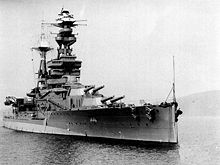Revenge class

|
|
|---|---|
|
|
|
| Displacement: | 28,000 ts standard 31,600 ts maximum |
| Length: | 190 m |
| Width: | 27.0 m |
| Draft: | 8.7 m |
| Drive: | 4 Parsons steam turbines , 18 boilers, 40,000 hp |
| Speed: | 23 kn (approx. 43 km / h) |
| Crew: | 997-1.150 |
| Armament: | Guns:
Torpedo tubes:
|
The Revenge class , also known as the Royal Sovereign class , was a class of five battleships in the British Royal Navy . The ships were ordered in 1913 and launched and put into service between 1915 and 1917.
Of the eight originally planned ships, three were canceled. The two battlecruisers of the Renown class were ordered for two of the canceled ships and built using the materials already provided. The names and service designations of the ships were also retained.
draft
The design was very similar to the previous Queen Elizabeth class , but the Revenge class was a bit smaller and slower and better protected.
Originally, in contrast to the exclusively oil-fired boilers of the Queen Elizabeth class, the ships' boiler systems were again to be provided with mixed coal / oil firing for propulsion. The Admiralty feared that it would otherwise be too dependent on oil imports. However, under pressure from Lord "Jackie" Fisher , who had returned to the Admiralty in November 1914 , the design was converted to pure oil-firing. The use of heating oil reduced the number of heaters required by 75, the design output increased from 31,000 HP to 40,000 HP and the design speed from 21 knots to 23 knots. In fact, the ships only reached 21.5 to 22 knots during test drives.
In addition to stronger belt armor than the Queen Elizabeth class, the Revenge class had a higher main armor deck and generally somewhat stronger deck armor. To protect against torpedoes and mines, the ships were the first in the British Navy to be equipped with torpedo bulges shortly before or after their commissioning , which is partly responsible for the fact that the ships never reached their design speed.
history
Two of the ships, the HMS Revenge and the HMS Royal Oak , were still in service during the First World War . Both ships took part in the Battle of the Skagerrak and suffered no damage. After the experience of the Skagerrak Battle, the horizontal armor over the ammunition chambers was reinforced by 1 inch (25.4 mm).
In the interwar period , the ships of the class were only slightly modified. First and foremost, facilities for on-board aircraft operations (catapults, cranes, but no hangars) were put on board and the flak was reinforced. In addition, the torpedo bulges were partially enlarged. The propulsion system was not modernized on any of the ships. In the case of the Royal Oak alone, the horizontal armor was reinforced by 4 inches (10.2 cm) above the ammunition chambers and 2.5 inches (6.4 cm) above the engine rooms in a major reconstruction from 1934 to 1936.
In the Second World War , the slow ships therefore took on rather auxiliary tasks. These consisted mainly in escorting convoy trains and later in fire support during landing operations. Their availability for these tasks relieved the modern battleships. In addition, these were too valuable to expose to the fire of the coastal batteries during landings.
The HMS Royal Oak is the best-known ship of the class, as it was the victim of the German submarine U 47 that penetrated the port of Scapa Flow on October 14, 1939 . This was the only Revenge-class ship lost. All other ships in the class were decommissioned after the war and scrapped in England or Scotland.
Ships of the class
- HMS Royal Sovereign , keel laid in 1914, commissioned in 1916. Awarded to the Soviet Union in 1944 under the name “Arkhangelsk” . Returned in 1949. Scrapped the same year.
- HMS Revenge , keel laid in 1913, commissioned in 1916, scrapped in 1948
- HMS Ramillies , keel laid in 1913, commissioned in 1917, scrapped in 1949
- HMS Royal Oak , keel laid in 1914, commissioned in 1916. Sunk by U 47 in Scapa Flow on October 14, 1939 .
- HMS Resolution , keel laid in 1913, commissioned in 1916, scrapped in 1948
See also
literature
- Siegfried Breyer: Battleships and battle cruisers 1905–1970. Pawlak Verlag, Herrsching 1989, ISBN 3-88199-474-2 (unchanged reprint of the Munich 1970 edition).
- Mike J. Whitley: Battleships of World War Two. Cassel, London 2001, ISBN 0-304-35957-2 .
- German translation: Battleships of World War II. Classes, construction dates, technology . Motorbuch-Verlag, Stuttgart 2003, ISBN 3-613-02289-3 .
- Bernard Ireland (text), Tony Gibbons (illustrations): Jane's Battleships of the 20th Century. Harper Collins Publ., London 1996, ISBN 0-00-470997-7 .
- Alan Raven, John Roberts: British battleships of World War II. The development and technical history of the Royal Navy's battleships and battlecruisers from 1911 to 1946 . Arms & Armor Press, London 1976, ISBN 0-85368-141-4 .
- German translation: The British battleships of the Second World War. Development and technical history of the Royal Navy battleships and battlecruisers from 1911 to 1946 . Bernard & Graefe Verlag, Bonn 2002, ISBN 3-7637-6229-9 (3 volumes).
Web links
- Data Sheet (English)
- Review of all British battleship types (English)
